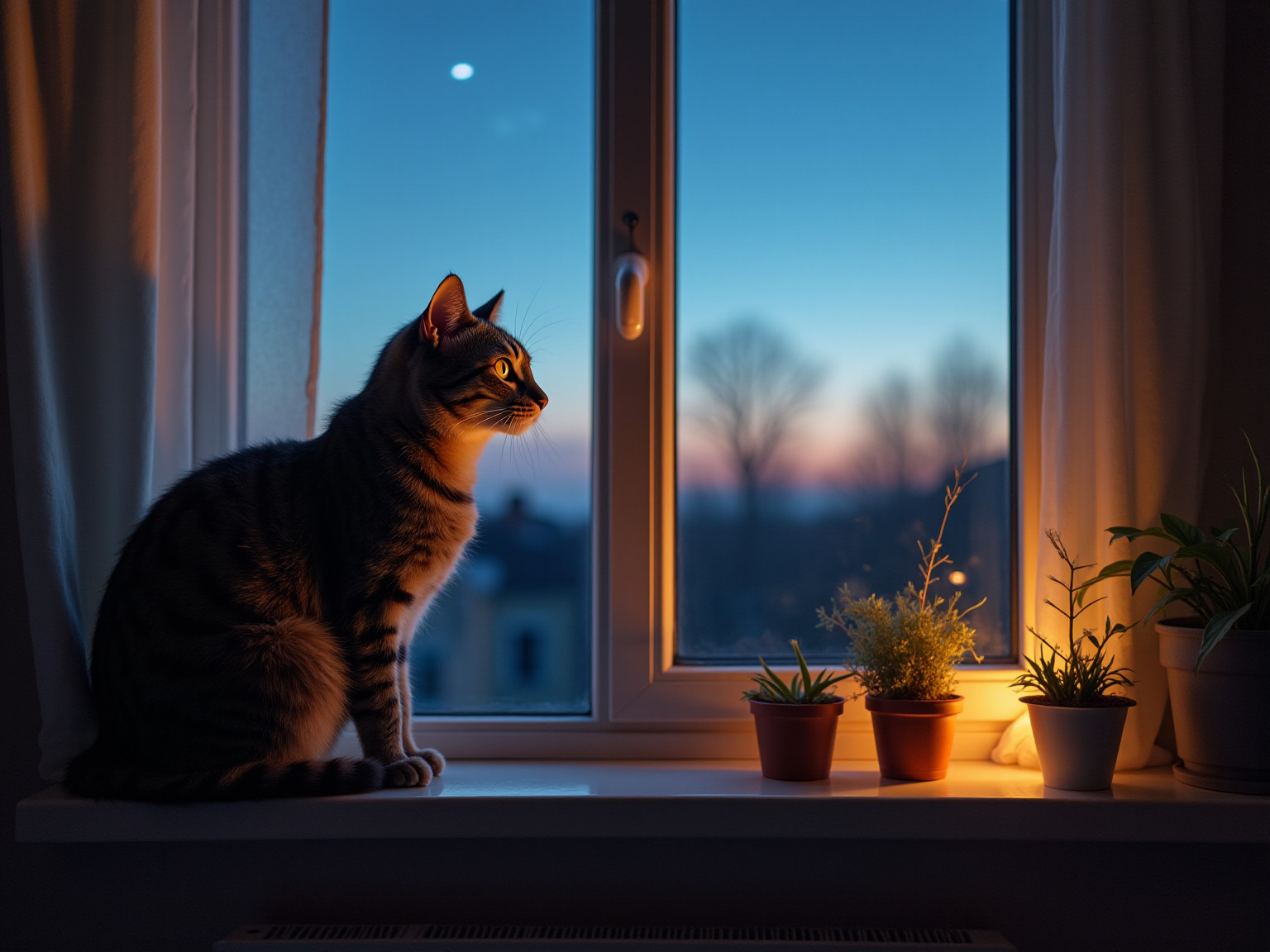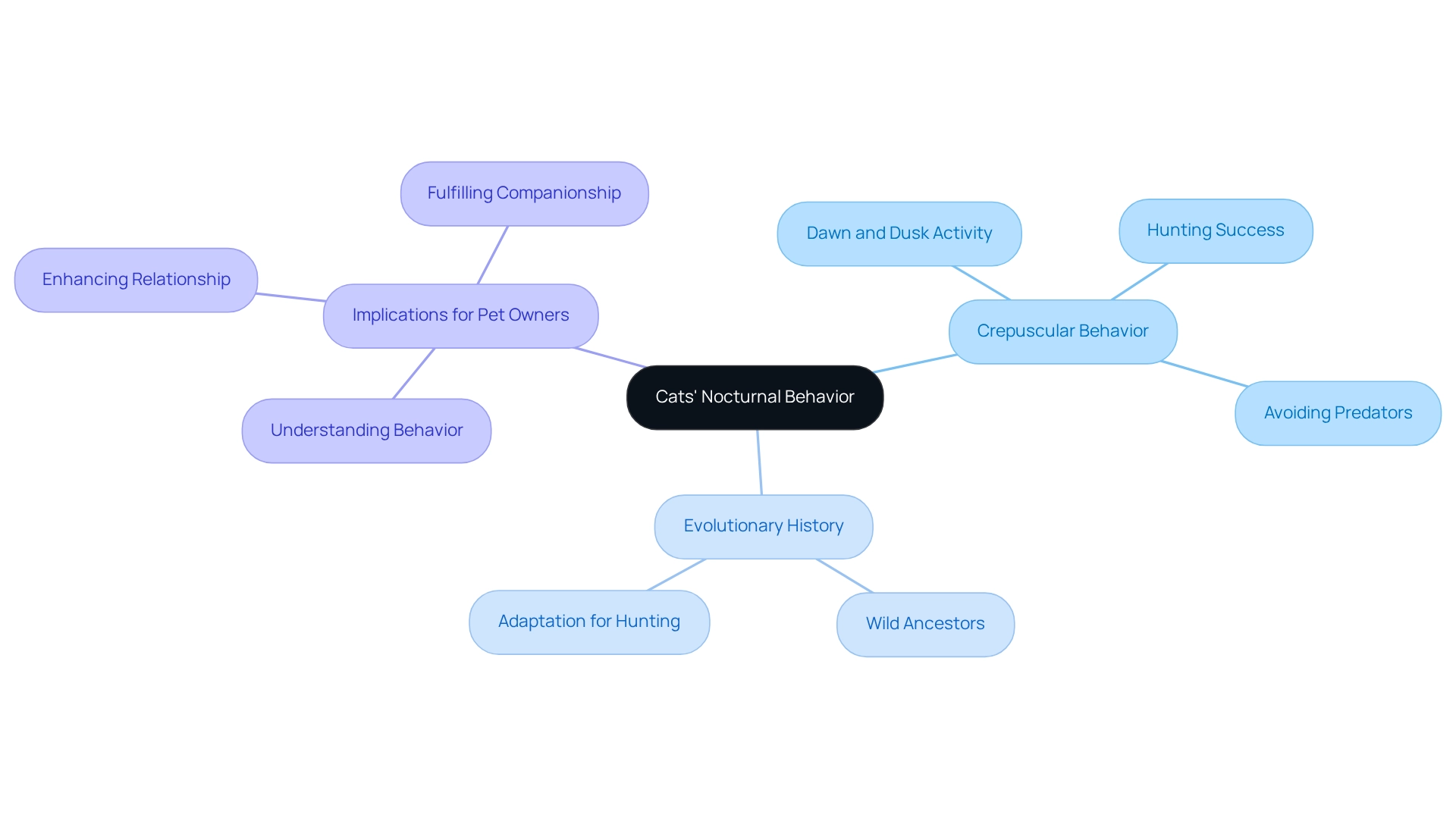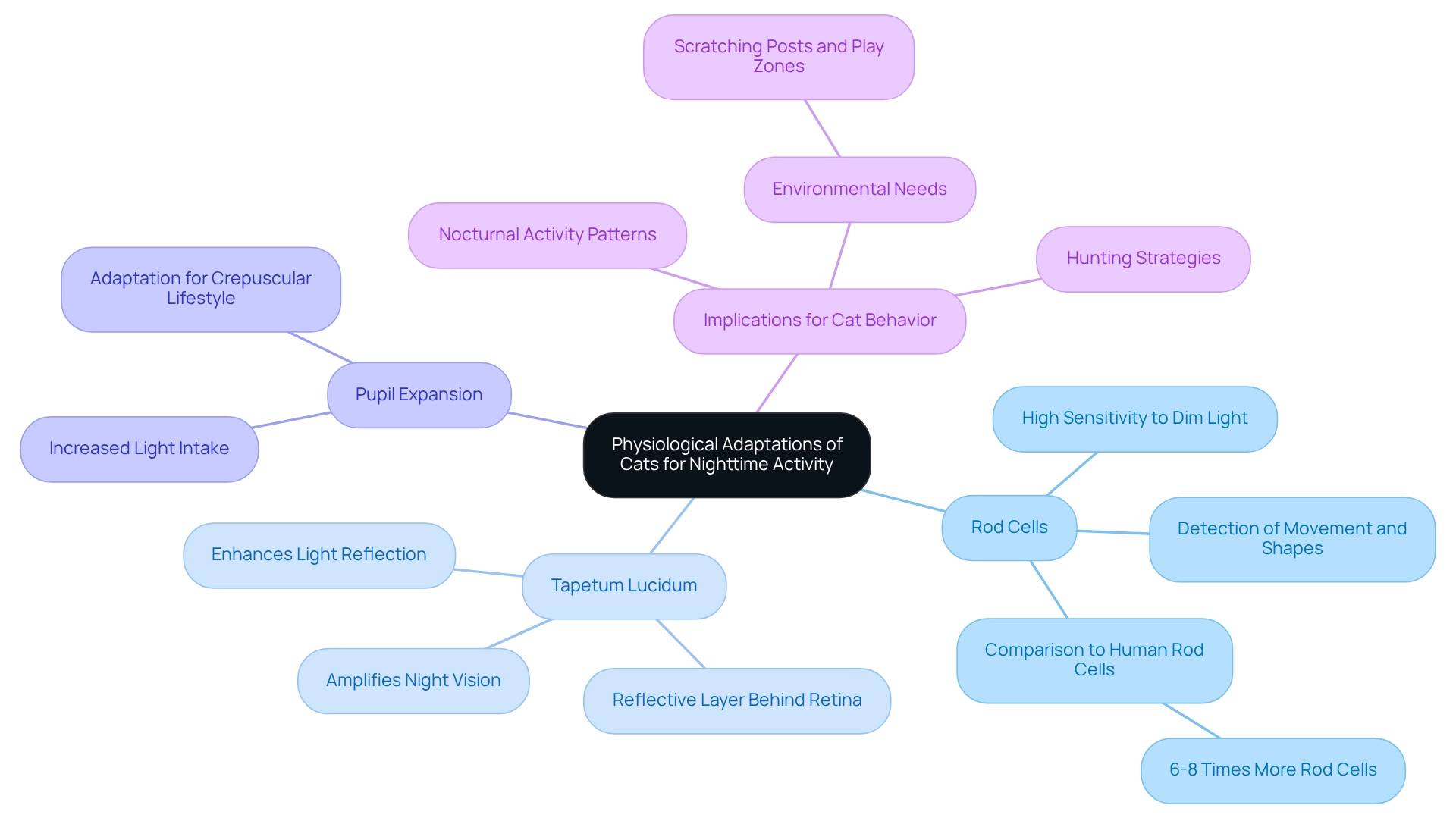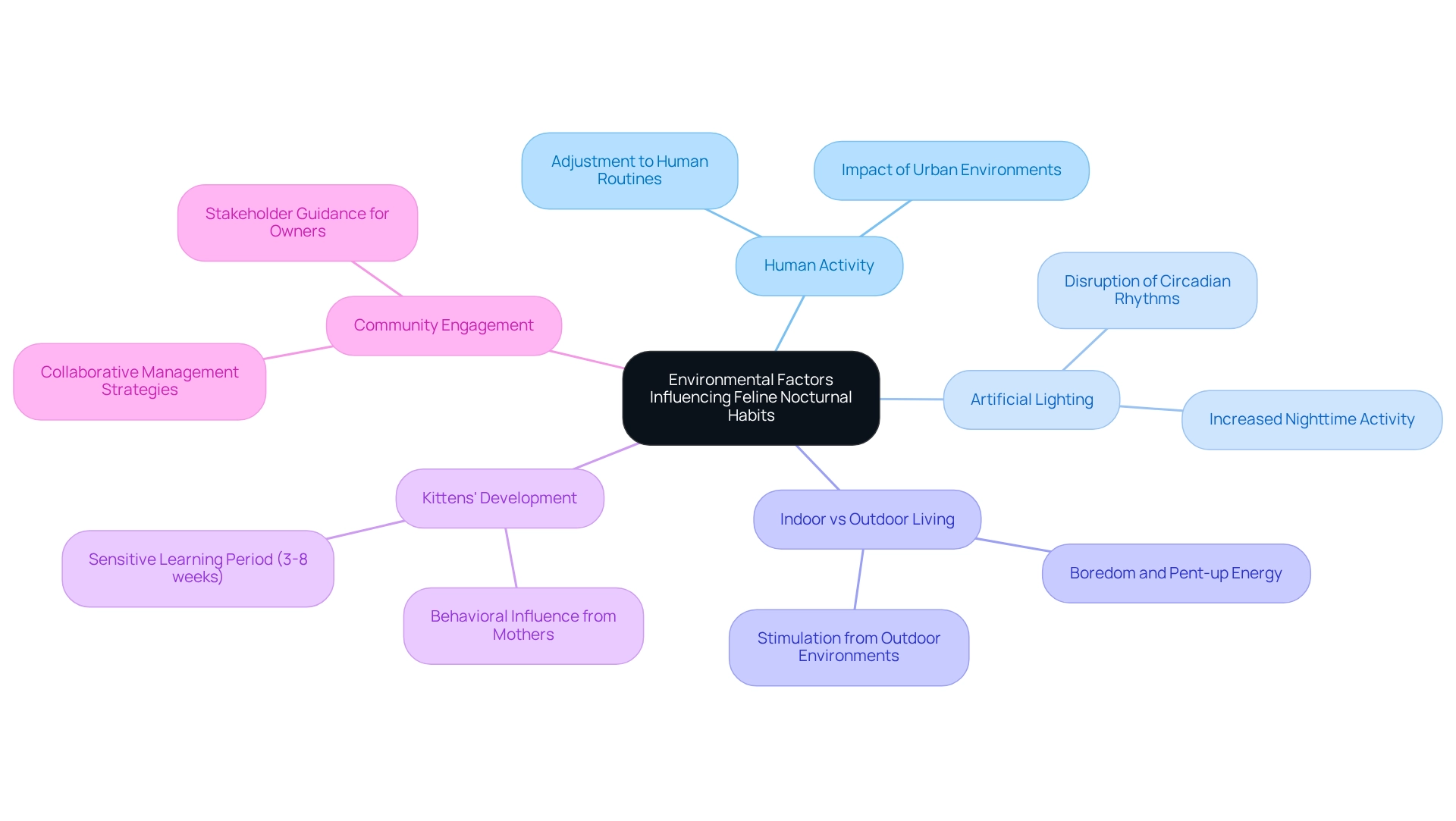
Why Are Cats Nocturnal? Understanding Their Nighttime Behavior
Overview
Cats are primarily crepuscular, which means they tend to be most active during the gentle hours of dawn and dusk. This fascinating behavior is deeply rooted in their evolutionary history as hunters. Understanding this activity pattern is essential, as it allows our feline friends to hunt effectively when their prey is most active, all while avoiding competition with larger predators. Recognizing these natural instincts can significantly enhance the bond between cats and their owners, fostering a deeper understanding and a more harmonious relationship. By embracing this knowledge, we can better cater to their needs and ensure they thrive in our care.
Introduction
In the world of our beloved feline companions, understanding the rhythms of their nighttime activity is essential for both cats and their caring owners. While many of us perceive our cats as nocturnal creatures, their true nature reveals a crepuscular lifestyle, marked by heightened activity during the serene hours of dawn and dusk. This fascinating behavior is deeply rooted in their evolutionary past as hunters, designed to maximize their success while minimizing competition. Yet, the interplay of physiological adaptations, environmental factors, and the realities of urban living complicates this picture further.
As devoted pet owners, navigating the challenges posed by our cats’ nighttime tendencies can be daunting. However, gaining insights into these behaviors can lead to more harmonious relationships and improved well-being for both parties. By exploring the intricacies of feline nocturnality, we can cultivate a deeper appreciation for these enigmatic creatures, paving the way for solutions that cater to their unique needs. Together, we can create an environment that respects their natural instincts while ensuring our own peace of mind.
Examine the Evolutionary Roots of Nocturnal Behavior in Cats
Many pet owners often feel confused about their cats’ behavior, mistakenly believing that cats are nocturnal creatures. In reality, cats are crepuscular, meaning they thrive during the beautiful moments of dawn and dusk. This fascinating behavior stems from their evolutionary history as hunters. Their wild ancestors, such as the African wildcat, learned to hunt during these twilight hours, when their prey—like rodents and birds—were most active. This adaptation not only enhanced their hunting success but also helped them avoid competition with larger predators that roamed during the day.
Understanding this natural instinct can evoke a sense of compassion in pet owners, as it reveals the reasons behind their feline friends’ activity levels and behaviors. By recognizing that your cat’s energetic bursts during these times are rooted in their evolutionary past, you can better appreciate their needs. This knowledge fosters a deeper connection and allows for a more harmonious relationship between you and your beloved pet. Embracing your cat’s natural rhythms can lead to a more fulfilling companionship, where both of you thrive together.

Understand the Physiological Adaptations Supporting Nighttime Activity
Cats possess extraordinary physiological adaptations that greatly enhance their ability to see and hunt in low-light conditions, a fact that many pet owners may find both fascinating and reassuring. Their eyes contain a high concentration of rod cells, which are particularly sensitive to dim light, allowing them to detect movement and shapes even in near darkness. In fact, felines have approximately six to eight times more rod cells than humans, enabling them to thrive in dimly lit environments. This remarkable ability is complemented by the tapetum lucidum, a reflective layer located behind the retina that amplifies their night vision by reflecting light that passes through the retina back into the eye. Such adaptations are essential for their hunting strategy, allowing them to spot prey in minimal light.
Moreover, felines can significantly expand their pupils, allowing more light to enter the eye—an important characteristic for their crepuscular lifestyle, during which they are most active at twilight, leading to the question of why are cats nocturnal. These physiological traits not only enhance their hunting instincts but also help explain why many felines are cats nocturnal, exhibiting increased energy levels at night. As veterinarian Sandra C. Mitchell observes, providing a suitable environment for our beloved pets, including appropriate scratching posts and play zones, can help channel their instinctive behaviors, including their nighttime habits.
Furthermore, understanding these adaptations can enhance the care provided at facilities like Jet Pet Resort, where personalized experiences for pets are prioritized. By acknowledging the unique needs of our feline friends, we can ensure that they receive the nurturing care they deserve, allowing them to thrive in a safe and supportive environment. This compassionate approach not only enriches their lives but also strengthens the bond between pets and their owners, fostering a sense of community and shared responsibility for their well-being.

Analyze Environmental Factors Influencing Feline Nocturnal Habits
The influence of environmental elements on the nighttime behaviors of our beloved house felines raises the question: are cats nocturnal, especially in bustling city environments where human involvement shapes their daily patterns? It’s important to recognize that our furry friends often adjust their actions to align with our routines; for instance, in a lively home during the day, they may shift their sleeping habits to be more active at night, which raises the question of why are cats nocturnal when we are around. The impact of artificial illumination is especially noteworthy, as it alters a cat’s perception of day and night, leading to the question of whether cats are nocturnal. As Phyllis, a Certified Veterinary Technician, compassionately points out, “Artificial lighting can disrupt a cat’s natural rhythms, making them more active at times when they would typically be resting.” Research indicates that exposure to artificial light can disturb natural circadian rhythms, which raises the question: are cats nocturnal as it encourages them to engage in more nighttime activities?
Moreover, indoor felines, who miss out on the stimulation of outdoor environments, may display heightened nocturnal activity, leading to the question: are cats nocturnal due to boredom or pent-up energy? This concern is particularly relevant during the sensitive developmental stage for kittens, between 3 to 8 weeks of age, when they learn behaviors from their mothers. By understanding these environmental influences, we can create nurturing habitats that cater to our felines’ innate behaviors, promoting a healthier and more fulfilling lifestyle.
Case studies highlight the importance of community engagement in managing outdoor cat populations, balancing the well-being of our pets with ecological considerations. Collaborative approaches that consider the perspectives of cat caretakers, conservationists, and policymakers can lead to effective solutions that enhance the welfare of cats in urban settings. It’s essential for stakeholders to provide guidance that empowers caretakers to make informed decisions regarding outdoor roaming, acknowledging the impact of human activity and environmental factors on feline behavior. By doing so, we can support our pets’ needs with love and understanding. In summary, understanding whether are cats nocturnal and recognizing the relationship between urban settings and feline nighttime behaviors is crucial for fostering a satisfying and enriching lifestyle for our cherished companions.

Address the Impact of Nocturnal Behavior on Pet Owners’ Lives
The nighttime habits of cats can significantly affect their caretakers, often leading to sleep disturbances and feelings of frustration. It’s not uncommon for cat guardians to feel overwhelmed; in fact, research shows that around 60% report experiencing disruptions due to their pets’ nighttime antics, which may include playful behaviors and vocalizations. This disruption can lead to sleep deprivation and increased stress levels, ultimately impacting the overall well-being of the individual. A recent study published in the Journal of Feline Medicine and Surgery in February 2024 underscores the importance of understanding feline behavior and its effects on their owners, highlighting the necessity for effective management strategies.
To navigate these challenges, there are several compassionate strategies that owners can adopt. Engaging cats in interactive play sessions during the evening can help them expend energy before bedtime, promoting a more restful night for everyone involved. For instance, Jet Pet Resort offers customized care plans that feature interactive play sessions designed to engage your cat and minimize nighttime disruptions. Additionally, establishing a regular feeding schedule that aligns with the caregiver’s routine can help manage the cat’s activity levels, fostering more sleep-friendly habits. By understanding why cats are nocturnal, caregivers can create a more harmonious living environment that meets the needs of both themselves and their beloved feline companions. Furthermore, testimonials from satisfied clients reveal how Jet Pet Resort’s personalized attention and engaging environment have greatly improved their pets’ nighttime behaviors. With a commitment to creating a comfortable and stimulating atmosphere, Jet Pet Resort ensures a better quality of life for both pets and their owners, all at competitive rates that reflect the value of their dedicated services.

Conclusion
Understanding the intricate dynamics of feline nocturnal behavior reveals much about the nature of our beloved cats. Their crepuscular instincts, honed through evolution, dictate their peak activity during dawn and dusk, aligning with their hunting patterns. Physiologically, their remarkable adaptations, such as enhanced night vision and the ability to thrive in low-light conditions, further explain why these behaviors manifest, even in a domestic setting.
Environmental factors, particularly in urban areas, play a crucial role in shaping these nocturnal habits. The influence of artificial lighting and the need for stimulation in indoor environments can lead to increased nighttime activity, which can understandably concern pet owners. Recognizing these elements allows for the creation of nurturing spaces that cater to a cat’s natural instincts and promote their overall well-being.
However, the impact of nocturnal behavior extends beyond the feline experience, significantly affecting pet owners. Sleep disturbances and stress can arise from a cat’s nighttime antics, which can be quite challenging. Yet, implementing effective strategies—such as engaging in interactive play and establishing consistent routines—can foster a more peaceful coexistence. By addressing the needs of both cats and their owners, a balanced and fulfilling relationship can be achieved, enhancing the quality of life for all involved. Embracing this understanding nurtures the bond between cats and their owners and honors the unique nature of these fascinating creatures.

